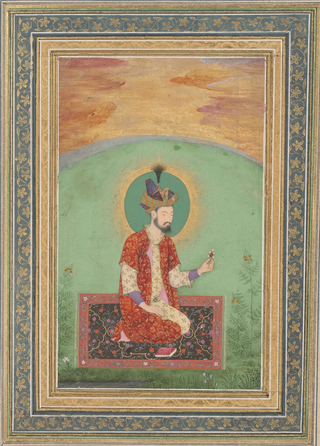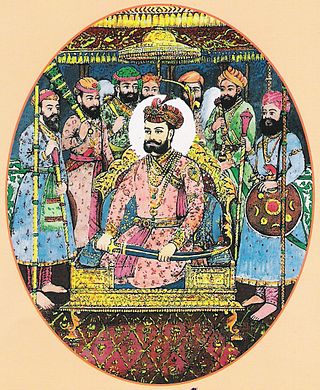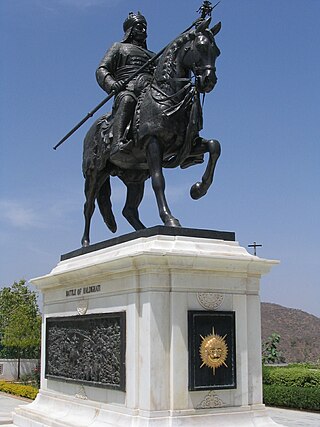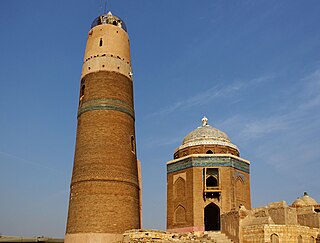
Nasir al-Din Muhammad, commonly known by his regnal name Humayun, was the second Mughal emperor, who ruled over territory in what is now Eastern Afghanistan, Bangladesh, Northern India, and Pakistan from 1530 to 1540 and again from 1555 to his death 1556. At the time of his death the Mughal Empire spanned almost one million square kilometres.

Sukkur is a city in the Pakistani province of Sindh along the western bank of the Indus River, directly across from the historic city of Rohri. Sukkur is the third largest city in Sindh after Karachi and Hyderabad, and 14th largest city of Pakistan by population. The city was originally founded by the Rai dynasty of Sindh. The modern city was built in the 1840s. New Sukkur was established during the British era alongside the village of Sukkur. Sukkur's hill, along with the hill on the river island of Bukkur, form what is sometimes considered the "Gate of Sindh".

Hemu was an Indian emperor who previously served as a general and Wazir of Adil Shah Suri of Sur Empire during a period in Indian history when Mughals and Afghans were vying for power across North India. He fought Afghan rebels across North India from Punjab to Bengal and Mughal forces of Humayun and Akbar in Agra and Delhi, winning 22 battles for Adil Shah Suri.

Shah Jahan II, born Mirza Rafi-ud-Daulah, was briefly the twelfth Mughal emperor in 1719.

Shah Jahan III, also known as Mirza Muhi-ul-Millat, was the sixteenth Mughal emperor, albeit briefly. He was the son of Muhi us-Sunnat, the eldest son of Muhammad Kam Bakhsh who was the youngest son of Aurangzeb. He was placed on the Mughal throne in December 1759 as a result of the intricacies in Delhi with the help of Imad-ul-Mulk. He was later deposed by Mughal chiefs, acting in the name of the exiled Mughal Emperor Shah Alam II.
The Samma dynasty was a medieval Sindhi dynasty ruled by the Samma tribe of Sindh in the Indian subcontinent, that ruled Sindh, as well as parts of Kutch, Punjab and Balochistan from c. 1351 to c. 1524 CE, with their capital at Thatta known as Sammanagar in modern day Sindh, Pakistan; before being replaced by the Arghun dynasty.

Rana is a historical title denoting an absolute Hindu monarch in the Indian subcontinent. Today, it is used as a hereditary name in the Indian subcontinent. "Rana" was formerly used as a title of martial sovereignty by Rajput kings in India. Rani is the title for the wife of a rana or a female monarch. It also applies to the wife of a raja. Compound titles include rana sahib, ranaji, raj rana,rana bahadur, and maharana.
Abu Bakr Shah Tughlaq, was a Muslim ruler of the Tughlaq dynasty. He was the son of Zafar Khan and the grandson of Sultan Feroze Shah Tughluq.

Alivardi Khan was the Nawab of Bengal from 1740 to 1756. He toppled the Nasiri dynasty of Nawabs by defeating Sarfaraz Khan in 1740 and assumed power himself.
Umar Bin Mohammad Daudpota was a Sindhi researcher, historian, linguist and scholar of the Indus Valley.

Shahrullah Kamboh, better known as Shahbaz Khan Kamboh, was one of the leading generals of Mughal emperor Akbar. He participated in some of the most difficult expeditions of Akbar and annexed numerous territories to the empire. He was too orthodox a Sunni Muslim for Akbar's taste, but not only was he tolerated but also was greatly valued. He was named “Mang Khan” by the people of Lahore meaning “ask the Khan and it will be done” In Punjabi due to his legendary generosity. The very first ‘guzar’ in Lahore Fort was named Guzar Shahbaz Khan known locally as Guzar Mang Khan.

Mirza Mahmud Shah Bahadur, also known by his regnal name Shah Jahan IV, was the eighteenth Mughal emperor for a brief period in 1788 after Shah Alam II was deposed by Ghulam Kadir, Mahmud Shah Bahadur was the son of a former Mughal Emperor, Ahmad Shah Bahadur. He himself became emperor for a brief period in 1788 as a puppet of Ghulam Kadir, after Shah Alam II had been deposed and blinded. He was allegedly put to death in 1790 by order of Shah Alam II, supposedly for usurping his authority in 1788.

Salima Sultan Begum was the third wife and chief consort of the Mughal emperor Akbar, and the granddaughter of Babur.
Mihr Nigar Khanum was the first wife of Sultan Ahmed Mirza, the King of Samarkand and Bukhara. She was a princess of Moghulistan by birth and was the eldest daughter of Yunus Khan, the Great Khan of Moghulistan and his chief consort Aisan Daulat Begum. She was also the aunt of Emperor Babur, the founder of the Mughal Empire of India as well as its first Emperor.
The Battle of Beas River took place between the Chagatai Khanate and the Mamluk Sultanate in 1285. Ghiyas ud din Balban arranged a military defense line across the Beas River as part of his "blood and iron" fortification chain strategy at Multan and Lahore as a countermeasure against the Chagatai Khanate invasion. Balban managed to repulse the invasion. However, his son Muhammad Khan was slain in battle.
The Battle of Lahore was battle which took place between the invading Ahmed Shah Abdali and Mir Mannu, the Mughal governor of Punjab in 1752. It took place at Lahore in current day Punjab province of Pakistan. After the Mughals were defeated, Abdali decided to retain Mannu as the city's governor on his own behalf.
Hazrat Begum, also known as Hazrat Mahal and Sahiba Begum, was a Mughal princess, as the daughter of Mughal Emperor Muhammad Shah. She was a wife of Ahmad Shah Durrani, the first emir of the Durrani Empire.

Mirza Jani Beg Tarkhan was the last Sultan of Sindh. He succeeded his grandfather Mirza Muhammad Baqi after his death. He ruled from 1585 to 1591 as an independent monarch of Sindh but was forced to submit to Mughal authority. He later involuntarily abdicated in 1593 and a Mughal Subahdar was appointed in his place. But due to social and public unrest, the Mughal authority appointed Jani in his place in 1594. Jani continued to serve as the Mughal Subahdar till his death in 1601.

Mir Masum Minar locally known as Masum Shah jo Minaro is a monument built in Sukkur during Mughal period. It is a high minaret of Mir Masum Shah. The Minaret is built of burnt bricks. It stands about 34 m high and stretches 28 m in circumference at the base. It is surmounted by a dome reached by an internal stair-case.













